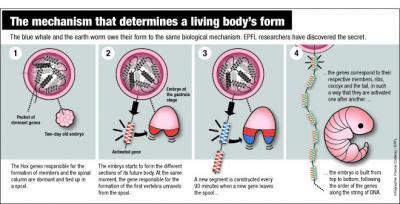From Blue Whales to Earthworms, a Common Mechanism Gives Shape to Living Beings
Why don't our arms grow from the middle of our bodies? The question isn't as trivial as it appears. Vertebrae, limbs, ribs, tailbone ... in only two days, all these elements take their place in the embryo, in the right spot and with the precision of a Swiss watch. Intrigued by the extraordinary reliability of this mechanism, biologists have long wondered how it works. Now, researchers at EPFL (Ecole Polytechnique Fédérale de Lausanne) and the University of Geneva (Unige) have solved the mystery.
Their discovery will be published October 13, 2011 in the journal Science.
The embryo is built one layer at a time
During the development of an embryo, everything happens at a specific moment. In about 48 hours, it will grow from the top to the bottom, one slice at a time -- scientists call this the embryo's segmentation. "We're made up of thirty-odd horizontal slices," explains Denis Duboule, a professor at EPFL and Unige. "These slices correspond more or less to the number of vertebrae we have."
Every hour and a half, a new segment is built. The genes corresponding to the cervical vertebrae, the thoracic vertebrae, the lumbar vertebrae and the tailbone become activated at exactly the right moment one after another. "If the timing is not followed to the letter, you'll end up with ribs coming off your lumbar vertebrae," jokes Duboule. How do the genes know how to launch themselves into action in such a perfectly synchronized manner? "We assumed that the DNA played the role of a kind of clock. But we didn't understand how."
When DNA acts like a mechanical clock
Very specific genes, known as "Hox," are involved in this process. Responsible for the formation of limbs and the spinal column, they have a remarkable characteristic. "Hox genes are situated one exactly after the other on the DNA strand, in four groups. First the neck, then the thorax, then the lumbar, and so on," explains Duboule. "This unique arrangement inevitably had to play a role."
The process is astonishingly simple. In the embryo's first moments, the Hox genes are dormant, packaged like a spool of wound yarn on the DNA. When the time is right, the strand begins to unwind. When the embryo begins to form the upper levels, the genes encoding the formation of cervical vertebrae come off the spool and become activated. Then it is the thoracic vertebrae's turn, and so on down to the tailbone. The DNA strand acts a bit like an old-fashioned computer punchcard, delivering specific instructions as it progressively goes through the machine.
"A new gene comes out of the spool every ninety minutes, which corresponds to the time needed for a new layer of the embryo to be built," explains Duboule. "It takes two days for the strand to completely unwind; this is the same time that's needed for all the layers of the embryo to be completed."
This system is the first "mechanical" clock ever discovered in genetics. And it explains why the system is so remarkably precise.
This discovery is the result of many years of work. Under the direction of Duboule and Daniël Noordermeer, the team analyzed thousands of Hox gene spools. With assistance from the Swiss Institute for Bioinformatics, the scientists were able to compile huge quantities of data and model the structure of the spool and how it unwinds over time.
The snake: a veritable vertebral assembly line
The process discovered at EPFL is shared by numerous living beings, from humans to some kinds of worms, from blue whales to insects. The structure of all these animals -- the distribution of their vertebrae, limbs and other appendices along their bodies -- is programmed like a sheet of player-piano music by the sequence of Hox genes along the DNA strand.
The sinuous body of the snake is a perfect illustration. A few years ago, Duboule discovered in these animals a defect in the Hox gene that normally stops the vertebrae-making process.
"Now we know what's happening. The process doesn't stop, and the snake embryo just keeps on making vertebrae, all identical, until the process just runs out of steam."
The Hox clock is a demonstration of the extraordinary complexity of evolution. One notable property of the mechanism is its extreme stability, explains Duboule. "Circadian or menstrual clocks involve complex chemistry. They can thus adapt to changing contexts, but in a general sense are fairly imprecise. The mechanism that we have discovered must be infinitely more stable and precise. Even the smallest change would end up leading to the emergence of a new species."
Recommend this story on Facebook, Twitter, and Google +1



















0 comments:
Post a Comment
Please do not spam Spam comments will be deleted immediately upon my review.